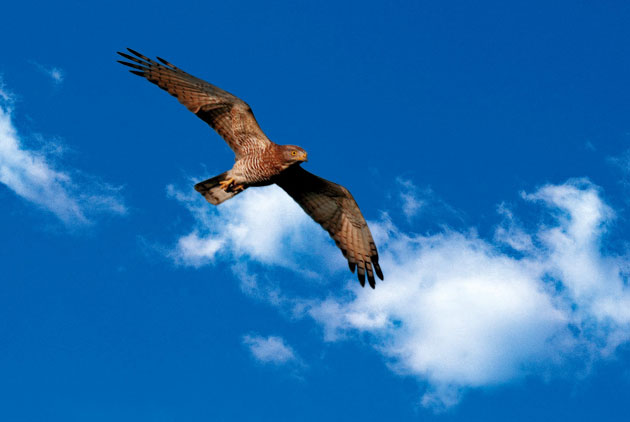The Hawks of Kenting

Source:CW
As the autumn winds begin to blow, so come the migratory hawks. Head south to Kenting to glimpse them soaring magnificently across the sky, and enjoy a peaceful autumn afternoon soaking in a hot spring fit for a Japanese prince.
Views
The Hawks of Kenting
By Chu Chia-YingFrom CommonWealth Magazine (vol. 507 )
With passage of the Autumn Equinox, the air begins to cool somewhat. The fluffy white clouds racing south across an impossibly blue sky remind me that my annual appointment with the hawks of Kenting has arrived yet again.
Every autumn, the air space above Taiwan becomes like a congested traffic corridor, jammed with flocks of migratory birds heading south for the winter. By far the most formidable of the formations amidst the fray are the migratory birds of prey: the Chinese sparrow hawks and gray-faced buzzard hawks (also known simply as "gray-faced hawks"). They come from Japan, the Korean Peninsula and northeast China, riding seasonal winds south to winter in the Philippines, Indonesia and other tropical island locales. Their most important stopover along their several thousand-kilometer migratory journey is here at Kenting on the Hengchun Peninsula.
'National Day Birds' on Parade
Beginning in early September the vanguard of Chinese sparrow hawks begins landing in Kenting in numbers reaching thousands and even tens of thousands per day. Shortly thereafter, in late September to early October, the larger gray-faced hawks begin to arrive and compete for space. During their rest here, the hawks take up temporary residence in the mountain areas surrounding the Hengchun Peninsula, eventually heading south when the weather demands.
Due to the timing of the gray-faced hawks' migratory passage, which happens to coincide with the "Double 10" national day celebration, they have long carried the moniker of "national day birds."
My association with national day birds began more than 20 years ago. At the time, hawk-watching in Kenting was just getting underway as an organized activity, and I accepted an invitation from some bird-watcher friends to join them on the Li De Bridge in Manjhou to watch the hawks coming in. I still remember that moment I arrived in Manjhou around three in the afternoon after the long trek from Taipei, I was immediately entranced by a large cast of hawks patrolling the skies above.
This convocation was preparing to settle in for the night, but before doing so they gathered together in the sky above. Once one flock had dispersed, another would form, seemingly forming ranks for evening roll call. It was a breathtaking sight to behold.
Landings and Takeoffs
While hawk-watching in Kenting, aside from the hawks alighting in the evening, another spectacle not to be missed is the morning "takeoff," which can be viewed at the break of each day from the vantage point of Sheding Nature Park high above Hengchun Peninsula. The "takeoff" is when casts of gray-faced and sparrow hawks gather at the first light of dawn, having had their fill of food and drink on the Hengchun Peninsula, and head out to sea via Cape Eluanbi, the southernmost tip of Taiwan, bound for even more southerly destinations. With the broad vista afforded by the vantage point of Sheding Nature Park, one can view the majestic sight of hawks taking flight from the surrounding tropical forest and gathering in the skies before heading south out over the azure sea.
As the katabatic winds of early October begin to blow in Kenting, the noisy summer-season tourists have already largely dispersed, yet the eco-drama played out in the surrounding wilds is only just beginning. In addition to the birds of prey migrating in multitudes through the skies above, on terra firma, Kenting also greets the arrival of the katabatic winds with the spectacle of the land crabs' migration back to the sea to lay eggs.
Hawks taking off at dawn and alighting in the afternoon, and land crabs out and about in the evening, add up to a full day of eco-spectacle that makes the trip quite worthwhile.
A Sip and a Soak at Sihchongsi
Naturally, the long journey to Kenting can't be all about nature watching. There's a spot on the Hengchun Peninsula that's been renowned throughout Taiwan since the Japanese colonial era, and it's my favorite spot for respite every time I visit the area. The springs at Sihchongsi are crystal-clear and odorless, and it's one of the few alkaline carbonate springs in Taiwan suitable for both bathing and imbibing. The best part is, due to its relatively remote location, it has yet to be overly developed. Compared with Taiwan's three other major hot spring areas – Beitou, Guanzihling and Yangmingshan – it's refreshingly spartan and peaceful.
Along the main drag in Sihchongsi's old quarter is the historic Cingcyuan Japanese-style Spa, the town's oldest, that traces its history back to its former days as a military officers' retreat during the Japanese colonial period.
Inside the spa, the bath reserved for the visiting Japanese Prince Takamatsu, younger brother of Emperor Hirohito, has been maintained. The enchanting atmosphere is complemented by the forests of the surrounding river valley, and if you allow your mind to lapse, you might just think you've really arrived at some country hot spring inn in rural Japan. It's a great place to spend half a day rejuvenating the spirit.
Translated from the Chinese by Brian Kennedy






